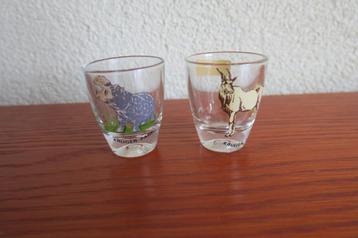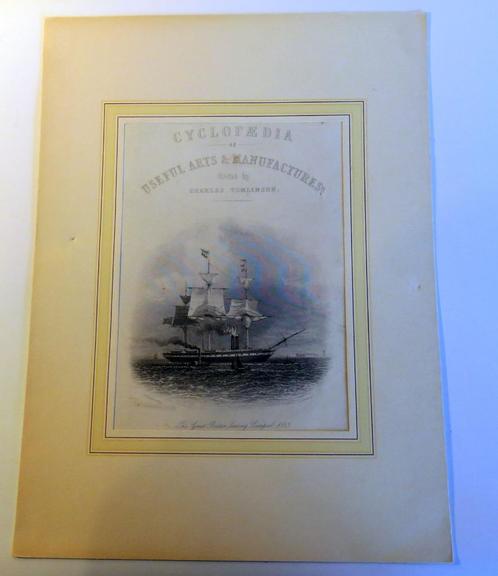Isambard Kingdom brunel interest: hand coloured engraving of the Steam Ship Great Britain leaving Liverpool published by Cyclopaedia of useful Arts & Manufacturers in 1853.
Publisher: Cyclopaedia of useful Arts & Manufacturers
Edited: Charles Tomlinson
Type: periodical card 15,5 x 25 cm (6.1” x 9.8”) tipped-in folio size 26 x 35 cm (10,23” x 13.78”)
Year published: 1853
Condition: engraving very good; paper frame some pits
SS Great Britain is a museum ship and former passenger steamship, which was advanced for her time. She was the longest passenger ship in the world from 1845 to 1854. She was designed by Isambard Kingdom Brunel (1806–1859), for the Great Western Steamship Company's transatlantic service between Bristol and New York. While other ships had been built of iron or equipped with a screw propeller, the Great Britain was the first to combine these features in a large ocean-going ship. She was the first iron steamer to cross the Atlantic, which she did in 1845, in the time of 14 days.
The ship is 322 ft (98 m) in length and has a 3,400-ton displacement. She was powered by two inclined 2 cylinder engines of the direct-acting type, with twin 88 in (220 cm) bore, 6-foot (1.8 m) stroke cylinders. She was also provided with secondary masts for sail power. The four decks provided accommodation for a crew of 120, plus 360 passengers who were provided with cabins, and dining and promenade saloons.
When launched in 1843, Great Britain was by far the largest vessel afloat. But her protracted construction time of six years (1839-1845) and high cost had left her owners in a difficult financial position, and they were forced out of business in 1846, having spent all their remaining funds refloating the ship after she ran aground at Dundrum Bay in County Down near Newcastle in what is now Northern Ireland, after a navigation error. In 1852 she was sold for salvage and repaired. Great Britain later carried thousands of immigrants to Australia from 1852 until being converted to all-sail in 1881. Three years later, she was retired to the Falkland Islands, where she was used as a warehouse, quarantine ship and coal hulk until she was scuttled and sunk in 1937, 98 years since being laid down at the start of her construction.
In 1970, after lying under water and abandoned for 33 years half a world away, Sir Jack Arnold Hayward, OBE (1923-2015) paid for the vessel to be raised and repaired enough to be towed north through the Atlantic back to the United Kingdom, and returned to the Bristol dry dock where she had been built 127 years earlier. Hayward was a prominent businessman, developer, philanthropist and owner of the English football club Wolverhampton Wanderers. Now listed as part of the National Historic Fleet, the Great Britain is a visitor attraction and museum ship in Bristol Harbour, with between 150,000 and 200,000 visitors annually.
Tomlinson’s Cyclopaedia of Useful Arts is a multi-volume encyclopedia focusing on manufacturing, mining, and engineering. It was edited by Charles Tomlinson, a Fellow of the Royal Society, and a lecturer at King’s College School, London. The original was published between 1852 and 1854. It was published in 1852 in two volumes (vol. 1, 832pp, vol. 2, 1052pp) with 40 steel engravings and 2,477 woodcuts. A supplement was published in 1862, which was published by James S. Virtue, London and New York City.
A new edition was published no earlier than 1866 with the intent of "keeping pace with the varied subjects of the Useful Arts and Manufactures, which are always enlarging their boundaries." Internally the new edition is organized into three volumes of 935, 956, and 740 pages (making it 38% larger than the original edition), but it was sold in various formats, including an eight-volume set. It has 63 full-page steel engravings and 3063 wood engravings (a few of which are a half page), for which the publishing companies of James Sprent Virtue were noted. It was printed by Virtue & Company, of London, and then also of New York.
Tags: White Star Line RMS Titanic RMS Olympic Harland & Wolff Belfast Southampton United Kingdom Liner Captain Crew Pre-Sinking Shipyard Yard Beken of Cowes Isma Imrie Co. International Mercantile Marine Company Belfast Fleet Collectible Steam Ship Steamship Isambard Kingdom Brunel Engineer Engineering

